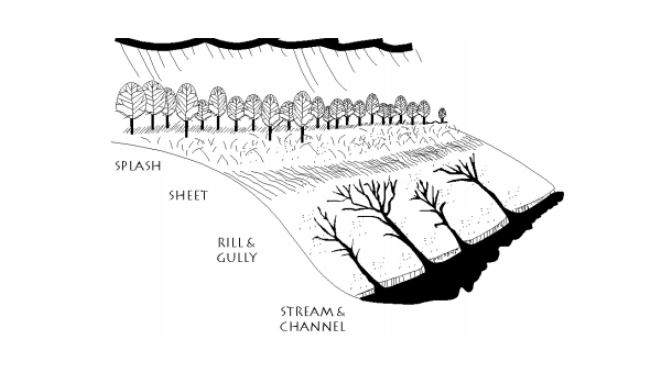Erosion: types, impacts and management actions
Soil erosion removes valuable topsoil which is the most productive part of the soil profile. The loss of this topsoil results in lower yields and higher production costs. In general, soil erosion has declined across Australia over the past 70 years due to improvements in farming practices however soil losses still occur with extreme wind or rainfall events, and after severe or prolonged drought (State of the Environment, 2016).
Types of erosion
There are various types of erosion that will impact the environment and productivity. In the central west the main types of erosion to consider are wind, water and sheet erosion. This removal of topsoil and subsoil by the actions of wind and water reduces land management options and reduces terrestrial and aquatic ecosystem function and productivity.
The diagram above shows the stages of water erosion. Water erosion starts with the splashing and the impact of the water droplets. This transits to sheet erosion, then rill and gully erosion. Finally, the gully that was formed may transform into a running stream of water if enough rain persists.
Impacts from erosion
Some of the possible impacts of erosion on your farm:
- Increased soil compaction.
- Loss of soil structure.
- Reduced organic matter in the soil.
- Reduced nutrients in the soil.
- Reduced ability of the soil to store water.
- Silt deposits.
- Increased salinity.
- Decreased water quality.
- Soil pH issues increased.
- Reduced ability of the soil to store water.
- Exposure of subsoil which often has less desirable physical and chemical properties.
Management practice considerations
The two most significant management practices that influence the risk of soil erosion are:
- the occurrence, intensity and timing of tillage operations, and
- the quantity and nature of surface cover.
Most of the erosion risk is due to cropping practices such as tillage and stubble burning. Grazing management is also an important factor, especially in dry years and droughts. The biggest risks associated with grazing occur when feed availability and the cover of annual crop and pasture residues is declining such as late summer and autumn.
Identifying the types of erosion you have is the first step in working towards fixing the problems. After this prioritise which areas need addressing first and consider the financial cost of each, taking into consideration the time that will need to be allocated to the task and subsequent management of the problem area.
What is it you want to achieve?
(Source: DPI North Coast fact sheet)
Protect the soil from raindrop and wind impact
- increase groundcover by reducing stock access or tillage and planting appropriate vegetation
Slow down the movement of surface water
- increase groundcover
Spread out concentrated flows of water
- build diversion banks, contour banks and ditches
Control the rapid descent of water
- install drop structures
- divert upslope run off
Trap suspended soil
- install sediment traps, settling ponds
- plant on the contour.
Workshops
Some soils are naturally more susceptible to erosion and as a result need adaptive management to help reduce the risk of erosion. If you are interested in finding out more about soil chemistry, soil physical characteristics, what the numbers in a soil test mean and management techniques and options then contact us to attend one of our Soil Pit and Kit workshops. These workshops, led by soil science experts, focus on practical skills that enable land managers to make better informed decisions about their soil and farm management. There is a workshop in Condobolin on the 25 May or we may be able to hold one in your area in the future. Contact Land Services Officer, Stephen Pereira to RSVP and find out more, 0409 814 182.
References
State of the Environment Website: https://soe.environment.gov.au/theme/land/topic/2016/soil-formation-and-erosion
Contact
For more information contact Senior Land Services Officer, Jasmine Wells, 0417488496.
